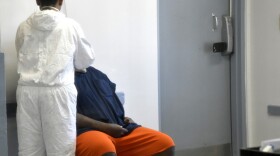Vaccine distribution in Michigan has been geographically uneven. But there’s a reason for that, says a public health official in the Upper Peninsula. The hard part, she says, can be explaining that to residents anxious to get vaccinated.
[Get Stateside on your phone: subscribe on Apple Podcasts or Google Podcasts today.]
When the COVID-19 vaccine rollout began, some counties in the U.P. were able to deliver more of the vaccine than they expected, says Kerry Ott, public information officer for the LMAS District Health Department, which represents Luce, Mackinac, Alger, and Schoolcraft counties in the eastern U.P.
But now that the state has implemented new vaccine distribution guidelines amid ongoing supply issues nationwide, vaccine distribution momentum in the U.P. has slowed down significantly, Ott says.
She says that earlier in the vaccine rollout, the district received a large shipment — 975 doses — of the Pfizer vaccine, and the area’s hospitals and health department were able to successfully store and administer the vaccines that were available to them.
“The big change came last week, when they announced that distribution would now be based on population,” Ott says. “So this week, as far as I understand, the entire Upper Peninsula did not receive any Pfizer vaccine, and LMAS District Health Department received a total of 600 doses for our four counties.”
COVID-19 vaccine shortages are continuing to hamper vaccine distribution throughout the United States, as well as in Michigan. As supply issues increase, the Michigan Department of Health and Human Services (MDHHS) is taking into consideration CDC guidance regarding social vulnerability. Researchers have found that prevalence of certain factors — like poverty, crowded housing, minority status and language, or transportation options — can put communities more at risk for becoming a COVID hotspot.
So now, when MDHHS distributes doses, it’s considering social vulnerability, as well as early data on COVID infections and deaths, when making decisions about where available doses should be directed and how much vaccine to send. That means that the LMAS district, which doesn’t see much of the crowding that can contribute to a high COVID death rate, is now receiving a smaller supply of the vaccine, says Ott.
She says this approach makes sense, but it’s difficult to explain the delay to people in the LMAS district who are eager to roll up their sleeves and get vaccinated.
“We are so appreciative that people want the vaccine, but it’s hard, because we had a lot to begin with, and now to have it brought down to such a low level, it’s a little harder to explain to the public, and even to our hospitals, who got no vaccine this week,” Ott says.
Ott adds that there’s been a decrease in COVID-19 testing in the LMAS district since the vaccine rollout began. Winter weather could be part of the testing slowdown, as cold temperatures prevent some of the larger-scale testing events that are possible in warmer months, she says. And hope regarding the vaccine process might be occupying the public’s attention at the moment. But, Otta says that doesn’t mean cases are going down in the district.
“We do have one county, Alger County, [that] has got an incredible increase in cases right now, and they have since the first of January,” she says. “From the first two weeks in January to the second two weeks in January, the number of confirmed cases of COVID in Alger County went up 80%.”
Ott says the desire to get vaccinated among residents in her area is high. And she’s encouraged by that, but until a majority of the population is vaccinated, everyone needs to continue taking safety precautions like proper mask wearing and social distancing, especially as the new, more infectious variant of the virus spreads in Michigan.
“We know people are tired of hearing it, but this is a race against time now, because that puts the virus ahead of our vaccine efforts, which are slowing down because of vaccine supply,” she says.
This post was written by Stateside production assistant Nell Ovitt.









